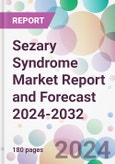Sezary Syndrome Market Outlook
The Sezary syndrome market size is anticipated to grow at a CAGR of 5.73% during the forecast period of 2024-2032, driven by the increasing research activity in new drug and vaccine development across the major markets.Sezary Syndrome: Introduction
Sézary syndrome is a rare form of cutaneous T-cell lymphoma, characterized by the presence of cancerous T-cells in the blood, skin, and lymph nodes. It manifests with widespread, itchy red rashes, skin scaling, and often, enlarged lymph nodes. Patients may also experience hair loss and changes in the nails. Sézary syndrome progresses slowly but is considered aggressive and challenging to treat. Treatment options include phototherapy, systemic chemotherapy, and biological therapies targeting specific aspects of the immune system.Key Trends in the Sezary Syndrome Market
There is a significant trend towards developing more rapid and accurate diagnostic methods, such as advanced PCR techniques and biomarker identification, to detect Sezary Syndrome causes swiftly and accurately.Efforts are underway to develop more effective antiviral drugs, immunotherapies, and targeted treatments, especially for Sezary Syndrome types that do not respond well to current treatments.
Given that many Sezary Syndrome cases are due to viral infections, there's a strong emphasis on vaccine development and distribution, such as the Japanese Sezary Syndrome vaccine, to prevent outbreaks in susceptible regions.
Recognizing the long-term effects Sezary Syndrome can have on patients, there's a growing trend towards providing comprehensive care that includes not just acute treatment but also long-term rehabilitation services to address neurological and psychological sequelae.
Increased awareness campaigns and public health initiatives are being conducted to educate people about the risks, preventive measures, and the importance of early diagnosis and treatment, especially in regions where Sezary Syndrome is more prevalent.
Increased funding for research into all aspects of Sezary Syndrome, from basic science to clinical studies, and a trend towards global collaboration among researchers, healthcare providers, and public health officials to combat Sezary Syndrome more effectively.
Sezary Syndrome Market Segmentation
Market Breakup by Treatment Type
- Standard Treatment
- Advance Treatment
Market Breakup by Diagnosis
- Immunophenotyping
- T-Cell Receptor
- Gene Rearrangement Test
- Others
Market Breakup by Drug Class
- Monoclonal Antibody
- Retinoid
- Histone Deacetylase Inhibitor
- Biologic Response Modifier
- Antibody-Drug Conjugate
- Corticosteroids
- Immune Stimulants
Market Breakup by Route of Administration
- Oral
- Parenteral
Market Breakup by Region
- United States
- EU-4 and the United Kingdom
- Germany
- France
- Italy
- Spain
- United Kingdom
- Japan
Sezary Syndrome Market Overview
In North America, the Sézary Syndrome market is influenced by advanced healthcare infrastructure and a strong focus on research and innovation. The region has well-established protocols for the diagnosis and treatment of rare cancers, including access to the latest therapies and clinical trials. There's also a significant emphasis on personalized medicine and targeted therapies, driven by a collaborative approach between research institutions, pharmaceutical companies, and healthcare providers.Europe's market is characterized by high standards of care and stringent regulatory frameworks for drug approval and patient safety. The region benefits from comprehensive healthcare systems, facilitating access to treatment and support for patients with rare conditions like Sézary Syndrome. Collaborative networks across countries contribute to research, facilitating the development and adoption of advanced therapies. Patient registries and specialized centers for rare diseases play a crucial role in improving diagnosis, treatment, and understanding of the disease.
The market in the Japan region is growing, with increasing awareness and improving healthcare infrastructure. However, challenges related to the diagnosis and treatment of rare diseases like Sézary Syndrome persist, including limited access to specialized care and advanced therapies. Efforts are being made to enhance healthcare capabilities and provide better support for patients with rare diseases.
Sezary Syndrome Market: Competitor Landscape
The key features of the market report include patent analysis, grants analysis, clinical trials analysis, funding and investment analysis, partnerships, and collaborations analysis by the leading key players.- Kyowa Kirin Co.
- Gilead Sciences
- Seattle Genetics
- Merck
- Amerigen Pharmaceuticals Limited
- STI Pharma
- Bioniz Therapeutics
- Minophagen Pharmaceutical Co.
- Bayer AG
- Novartis AG
- Shionogi Inc.
- Eisai Co.
- Hikma Pharmaceuticals PLC
- Innate Pharma
- BE Biopharma
This product will be delivered within 5-7 business days.
Table of Contents
1 Preface
3 Sezary Syndrome Overview
4 Patient Profile
5 Sezary Syndrome Epidemiology Analysis - 7MM
6 Sezary Syndrome Market Overview - 7MM
7 Sezary Syndrome Market Landscape - 7MM
8 Sezary Syndrome Challenges and Unmet Needs
10 Sezary Syndrome Market Dynamics
11 Sezary Syndrome Market Segmentation - 7MM
12 United States Sezary Syndrome Market
13 EU-4 and United Kingdom Sezary Syndrome Market
14 Japan Sezary Syndrome Market
15 Patent Analysis
16 Grants Analysis
17 Clinical Trials Analysis
18 Funding Analysis
19 Partnership and Collaborations Analysis
20 Supplier Landscape
21 Sezary Syndrome Market - Distribution Model (Additional Insight)
23 Company Competitiveness Analysis (Additional Insight)
24 Payment Methods (Additional Insight)
Companies Mentioned
- Kyowa Kirin Co.
- Gilead Sciences
- Seattle Genetics
- Merck
- Amerigen Pharmaceuticals Limited
- STI Pharma
- Bioniz Therapeutics
- Minophagen Pharmaceutical Co.
- Bayer AG
- Novartis AG
- Shionogi Inc.
- Eisai Co.
- Hikma Pharmaceuticals PLC
- Innate Pharma
- BE Biopharma
Methodology

LOADING...







